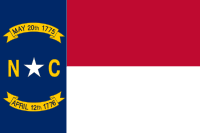Wilmington, North Carolina
| Wilmington, North Carolina | |
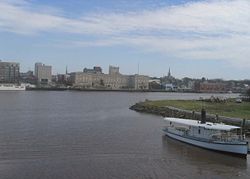 |
|
| Nickname(s): Port City, Dub-Town, The City out of the City, Hollywood of the East | |
|
|
|
| Coordinates: | |
| Country | United States |
|---|---|
| State | North Carolina |
| County | New Hanover |
| Incorporated | December 31, 1739 |
| Government | |
| - Mayor | Bill Saffo |
| Area | |
| - Total | 41.5 sq mi (107.4 km²) |
| - Land | 41.0 sq mi (106.2 km²) |
| - Water | 0.5 sq mi (1.2 km²) |
| Elevation | 30 ft (9 m) |
| Population (2007) | |
| - Total | 99,623 |
| - Density | 1,849.8/sq mi (714.2/km²) |
| Time zone | Eastern (EST) (UTC-5) |
| - Summer (DST) | EDT (UTC-4) |
| ZIP codes | 28401-28412 |
| Area code(s) | 910 |
| FIPS code | 37-74440[1] |
| GNIS feature ID | 1023269[2] |
| Sister cities | Dandong, China Doncaster, United Kingdom Bridgetown, Barbados |
Wilmington is a city in and the county seat of New Hanover County, North Carolina, United States.[3] The population was 75,838 at the 2000 Census.[1] A July 1, 2007 United States Census Bureau estimate placed the population at 99,623.[4] Wilmington is the principal city of the Wilmington Metropolitan Statistical Area, a metropolitan area that covers New Hanover, Brunswick, and Pender counties in southeastern North Carolina,[5] which had an estimated population of 339,511 as of July 1, 2007.[6] It was named in honor of Spencer Compton, the Earl of Wilmington, who was Prime Minister under George II.
Wilmington was settled on the Cape Fear River and offers its historic downtown with its one mile long Riverwalk as a main tourist attraction. It is minutes away from nearby beaches. The National Trust for Historic Preservation named Wilmington, North Carolina one of its 2008 Dozen Distinctive Destinations[7]. City residents have the advantage of living nestled between the river and the ocean with Wrightsville Beach a short 20 minute drive from downtown.
In 2003 the city received, through an act of Congress, the designation of "A Coast Guard City".[8] The city is also home port for the USCGC Diligence, a United States Coast Guard medium endurance cutter.[9].
Wilmington is also known as the childhood home of basketball great Michael Jordan and journalist David Brinkley; famous Wilmington natives include Robert Ruark, Sonny Jurgenson, Charles Kuralt, Charlie Daniels, Roman Gabriel, Meadowlark Lemon, Trot Nixon and Alge Crumpler. It is also home to the World War II Battleship USS North Carolina (BB-55). Now a war memorial, the ship is open to public tours and is on display across from the downtown port area. The town is home to the University of North Carolina Wilmington, the Wilmington Hammerheads USL soccer team, the training camp site for the Charlotte Bobcats and the Cape Fear Museum. The city has become a major center of American film and television production; motion pictures such as A Walk To Remember, Blue Velvet, Teenage Mutant Ninja Turtles, Empire Records, Cape Fear, Black Knight, 28 Days, The Crow (death place of Brandon Lee), Nights in Rodanthe and the controversial Dakota Fanning film Hounddog; as well as television shows such as Matlock, Surface, The WB's Dawson's Creek and One Tree Hill have been produced there. [10]
Contents |
Geography
Wilmington is located at (34.223232, -77.912122).[11]. It is the Eastern Terminus of a major East-West interstate Highway---I-40 which ends at Barstow, California where it joins I-15, the Gateway to Southern California, some 2720 miles away, passing through many major cities and State Capitals along the way.
According to the United States Census Bureau, the city has a total area of 41.5 square miles (107.4 km²). 41.0 square miles (106.2 km2) of it is land and 0.5 square miles (1.2 km2) of it (1.16%) is water.
Climate
Wilmington has a humid subtropical climate.
- Winters are generally cool with temperatures in the 50's and 60's F.
- Spring has temperatures in the 70's and 80's. The presence of abundant dense vegetation in the area causes significant pollen dusting in the springtime that tends to turn rooftops and cars yellow.
- Summer brings humidity with temperatures in the 80's and 90's F. Heat Indexes can easily break the 100 °F mark. Due to the proximity of warm Atlantic Ocean waters, the area may be hit by a tropical cyclone during the summer, at an average of once every 7 years.
- Fall is also generally humid at the beginning, with the same tropical threats as the summer. Temperatures hover mostly in the 70's and 80's. Some of the deciduous trees may lose their leaves; however most trees in the area are evergreens and therefore remain green year-round.
| Month | Jan | Feb | Mar | Apr | May | Jun | Jul | Aug | Sep | Oct | Nov | Dec | Year |
|---|---|---|---|---|---|---|---|---|---|---|---|---|---|
| Record high °F (°C) | 82 (28) |
85 (29) |
89 (32) |
95 (35) |
98 (37) |
104 (40) |
102 (39) |
103 (39) |
98 (37) |
95 (35) |
87 (31) |
82 (28) |
104 (40) |
| Average high °F (°C) | 56 (13) |
60 (16) |
66 (19) |
74 (23) |
81 (27) |
86 (30) |
90 (32) |
88 (31) |
84 (29) |
76 (24) |
68 (20) |
60 (16) |
74 (23) |
| Average low °F (°C) | 36 (2) |
38 (3) |
44 (7) |
51 (11) |
60 (16) |
68 (20) |
72 (22) |
71 (22) |
66 (19) |
54 (12) |
45 (7) |
38 (3) |
54 (12) |
| Record low °F (°C) | 5 (-15) |
10 (-12) |
9 (-13) |
30 (-1) |
35 (2) |
48 (9) |
55 (13) |
55 (13) |
44 (7) |
27 (-3) |
16 (-9) |
0 (-18) |
0 (-18) |
| Precipitation inches (cm) | 4.5 (11.5) |
3.7 (9.3) |
4.2 (10.7) |
2.9 (7.5) |
4.4 (11.2) |
5.4 (13.6) |
7.6 (19.4) |
7.3 (18.6) |
6.8 (17.2) |
3.2 (8.2) |
3.3 (8.3) |
3.8 (9.6) |
57.1 (145) |
| Source: weather.com[12] August 2007 | |||||||||||||
- Annual Average High Temperatures: 90 °F (summer) 60 °F (winter)
- Annual Average Low Temperatures 72 °F (summer) 38 °F (winter)
- Highest Recorded Temperature: 104 °F (1952)
- Lowest Recorded Temperature: 0 °F (1989)
- Warmest Month: July
- Coolest Month: February
- Highest Precipitation: July
- Annual Precipitation: 57.07 inches
History
Although there had been attempts to settle the Cape Fear region in the 1600s, the first permanent English settlers established themselves in the area in the 1720s. The town of Wilmington was incorporated in 1739. A number of the first settlers of the region came from South Carolina and Barbados. Slavery came early to the region as landowners used slave labor to exploit the region's natural resources. The forest provided the region's major industries through the 18th and most of the 19th century: naval stores and lumber fueled the economy both before and after the American Revolution. However, the most significant event in Wilmington's history is the coup d'état and Massacre of 1898.
Civil War
During the Civil War the port was a major base for Confederate blockade runners. It was captured by Union forces only in February 1865, approximately one month after the fall of Fort Fisher had closed the port. Since almost all the action was some distance from the city itself, a number of Antebellum homes and other buildings are still extant.
Massacre of 1898
In November 1898 Wilmington was the scene of a violent attack by a well-organized group of whites who destroyed the printing press of the African American newspaper The Daily Record and set fire to the building in response to an editorial that "insulted white womanhood", which was credited to editor Alex Manly. The mob then went to the north side of town, where an unknown number of African Americans were murdered by lynching and many hundreds more were run out of town. No whites were killed during the incident.
At the same time, the Republican mayor and city council were forced to resign their offices and the leader of the white mob was then installed as mayor, these events precisely fitting the definition of a coup d'état. The events in Wilmington—which was the largest city in the state at the time—helped make North Carolina into a Democratic Party-controlled state. They also helped institute Jim Crow and disenfranchisement which lasted until the African-American Civil Rights Movement in the United States in the second half of the 20th century.
In 2006 the 1898 Wilmington Race Riot Commission completed its official report on the event[13]. Consisting of thirteen commissioners appointed by the legislature, the governor, mayor and city council of Wilmington, the commission was assisted by the staff of the North Carolina Department of Cultural Resources. They used the experience of the Rosewood Report (completed 1993), and the Tulsa Report (completed 2001) as a model and set out to provide detailed explanations for the causes and effects of the riots and to propose a series of recommendations to address the wrongs perpetrated by earlier generations. The resolution also apologized to those affected by the riots and their repercussions and renounced these actions.

Cityscape
Downtown/Old Wilmington is home to Historic Neighborhoods and buildings such as the Sir Water Wilmington Hotel Build in the late 20th Century, the restored City Market.
Demographics
As of the census[1] of 2000, there were 75,838 people, 34,359 households, and 17,351 families residing in the city. The population density was 1,849.8 people per square mile (714.2/km²). There were 38,678 housing units at an average density of 943.4/sq mi (364.2/km²). The racial makeup of the city was 70.57% White, 25.82% African American, 0.35% Native American, 0.90% Asian, 0.09% Pacific Islander, 1.14% from other races, and 1.13% from two or more races. Hispanic or Latino of any race were 2.63% of the population.
There were 34,359 households out of which 20.4% had children under the age of 18 living with them, 33.5% were married couples living together, 14.0% had a female householder with no husband present, and 49.5% were non-families. 36.6% of all households were made up of individuals and 11.3% had someone living alone who was 65 years of age or older. The average household size was 2.10 and the average family size was 2.77.
In the city the population was spread out with 18.4% under the age of 18, 17.2% from 18 to 24, 28.5% from 25 to 44, 20.6% from 45 to 64, and 15.3% who were 65 years of age or older. The median age was 34 years. For every 100 females there were 87.5 males. For every 100 females age 18 and over, there were 85.0 males.
The median income for a household in the city was $31,099, and the median income for a family was $41,891. Males had a median income of $30,803 versus $23,423 for females. The per capita income for the city was $21,503. About 13.3% of families and 19.6% of the population were below the poverty line, including 25.9% of those under age 18 and 12.0% of those age 65 or over.
Transportation
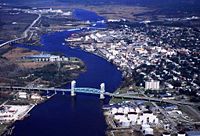
- The City of Wilmington offers transient, short-term, & long-term docking facilities in Historic Downtown Wilmington along the scenic Cape Fear River approximately 15 miles from the Intracoastal Waterway. Docks accommodating vessels up to 200' with 30 and 50 amp power service are available within walking distance to area attractions, hotels, shopping, dining, theater, nightlife, laundry, post office, bank, pharmacy, and supplies.
- Interstate Highway: The eastern terminus of I-40 is in Wilmington, sections of I-140 are open, and there are plans to extend I-20 and I-74 to Wilmington.
- The Wilmington International Airport serves the area with commercial air service provided by Delta Air Lines and US Airways. The airport is also home to two fixed base operations (FBO's) which currently house over 100 private aircraft. ILM maintains a separate International Terminal providing a full service Federal Inspection Station to clear international flights. This includes U.S. Customs and Border Protection, U.S. Dept of Agriculture and the U.S. Dept of Immigration. The airport is a quick 4 mile, 10 minute taxi ride from downtown.
- Greyhound Lines offers daily service to Raleigh, NC.
- Once in Wilmington the Cape Fear Public Transportation Authority, operating as Wave Transit provides a variety of public transportation options including fixed bus routes, shuttles, and a free downtown trolley.
- Bicycle: The NC-DOT Cape Fear Run bicycle route connects Apex to Wilmington and closely parallels the RUSA 600 km brevet route[14].
Business
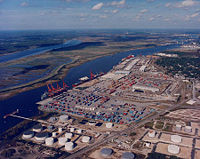
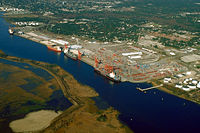
Wilmington experienced staggering growth in the 1990s, ranking at one point as the second fastest growing city in the country, behind only Las Vegas. Economists have forecast growth in the Greater Wilmington area to be the fastest in the state between 2004-2010, averaging 7%.
Located on the Cape Fear River, which flows into the Atlantic Ocean, Wilmington is a sizable seaport, including private marine terminals and the North Carolina State Ports Authority's Port of Wilmington. A major international seaport, the North Carolina International Port is being planned down the river in Southport.
Highways
 Interstate 140 (North Carolina)
Interstate 140 (North Carolina) - I-40
- I-40 - U.S. 17
- U.S. 17 - U.S. 74
- U.S. 74 - U.S. 74
- U.S. 74 - U.S. 421
- U.S. 421 - U.S. 117
- U.S. 117 - NC 133
- NC 133 - NC 132
- NC 132
Top employers
- New Hanover Regional Medical Center
- New Hanover County Schools
- New Hanover County, North Carolina
- Verizon Wireless
- Time Warner Cable
- UNC Wilmington
- General Electric
- Corning Incorporated
- PPD, Inc.
- City of Wilmington
- Port of Wilmington
- Reeds Jewelers
Category:Companies based in Wilmington, North Carolina
Media
Newspapers
- Encore Magazine is a weekly arts and entertainment publication - owned by Wilmington Media.
- The Star-News is Wilmington's daily regional newspaper - owned by the New York Times.
- The Wilmington Journal is a weekly African-American newspaper.
Television
Broadcast
The Wilmington television market is ranked 136 in the United States, and is the smallest DMA in North Carolina. The broadcast stations are as follows:
- WWAY, Channel (3), (ABC affiliate) Licensed to Wilmington, own by Morris Multimedia
- WECT, Channel (6), (NBC affiliate) Licensed TO Wilmington, own by Raycom Media
- WILM-LD, Channel (10), (CBS affiliate) Licensed to Wilmington, own by the Capitol Broadcasting Company
- WSFX-TV, Channel (26), (Fox affiliate) Licensed to Wilmington, own by the Raycom Media
- WUNJ-TV, Channel (39), (PBS affiliate, part of the UNC-TV Network)
- W47CK, Channel (47), (MyNetworkTV affiliate, uses fictional WMYW calls on-air)
- W51CW, Channel (51), (TBN affiliate)
Subscriber
Wilmington is also home of the Coastal Bureau of News 14 Carolina
The region is also served by a cable-only affiliate of The CW, WBW, channel 29 on Time Warner Cable and channel 17 on Charter Communications.
On September 8, 2008 at 12 Noon, WWAY, WECT, WSFX, WILM-LP and W51CW all turned off their analog signals, making Wilmington the first market in the nation to go digital-only as part of a test by the FCC to iron out transition and reception concerns before the nationwide shutoff, and because the area's digital channel positions will remain unchanged after the transition.[15] WUNJ will not participate and will keep their analog signal on until the national digital switchover date of February 17, 2009, as they are the official area conduit of emergency information in the area.[16] W47CK will not participate due to their low-power status; FCC rules currently exempts low-powered stations from the 2009 analog shutdown.[17] WILM-LP and W51CW have chosen to participate, even though they are exempt as LPTV stations. This was a voluntary shutdown and none of the stations have surrendered their analog licenses back to the FCC, so they could resume analog signals before February if desired.
Despite Tropical Storm Hanna making landfall southwest of Wilmington two days before (September 6), the switchover continued as scheduled. The ceremony was marked by governmental and television representatives flipping a large switch (marked with the slogan "First in Flight, First in Digital") from analog to digital.[18]
Broadcast radio
Public and Listener-supported
- 88.1 FM WGHW - Christian Programs from Church Planters Of America
- 88.5 FM WZDG - Christian Rock ("88.5, The Edge")
- 88.9 FM WKVC - Contemporary Christian ("K-Love")
- 89.7 FM WDVV - Worship & Praise Music("The Dove, 89.7")
- 90.5 FM WWIL - Christian Music & Teaching Programs("Life 90.5")
- 91.3 FM WHQR - Public Radio
- 92.3 FM WQSL - Urban Contemporary ("92.3, The Touch")
- 92.7 FM WBPL - Wilmington Catholic Radio
- 93.7 FM WNTB - Talk Radio ("The Big Talker FM")
- 94.5 FM WKXS - Classic Hits ("94.5, The Hawk")
- 95.5 FM W238AV - Contemporary Christian ("K-LOVE")
- 95.9 FM W240AS - Christian Programs from WOTJ, Morehead City
- 97.3 FM WMNX - Hip Hop/R & B ("Coast 97.3")
- 98.3 FM WSFM - Alternative ("Surf 98.3")
- 98.7 FM WLGD - Popular Latin music ("La Grand D")
- 99.9 FM WKXB - Oldies ("Jammin' 99.9")
- 100.5 FM W263BA - Contemporary Christian ("K-LOVE")
- 101.3 FM WWQQ- Country ("Double Q, 101")
- 102.7 FM WGNI - Hot AC ("102.7 GNI")
- 103.7 FM WBNE - Classic Rock (103.7,"The Bone")
- 104.5 FM WILT - Adult Hits ("Will FM")
- 105.5 FM WXQR - Rock ("Rock 105")
- 106.3 FM WLTT - Talk Radio ("The Big Talker FM")
- 106.7 FM WUIN - Variety Hits ("The Penguin")
- 107.5 FM WAZO - Top 40 ("Z 107.5")
- 630 AM WMFD - Sports ("ESPN Radio, AM 630")
- 980 AM WAAV - News, Talk, Sports ("News, Talk, & Sports 980 The Wave")
- 1180 AM WMYT - Spanish Christian ("Radio Alegre")
- 1340 AM WLSG - Southern Gospel ("God's Country, 1340")
- 1490 AM WWIL - Urban Gospel ("Gospel Joy, 1490")
Internet-only
The Wilmington Telgram a professionally run and locally owned online daily newspaper and only online publication that is an associate member of the NC press Association. Updated Monday through Friday at http://www.wilmington3.com
Performing Arts
The city supports a very active calendar with its showcase theater, the Thalian Hall Center for the Performing Arts, hosting about 250 events annually. The complex has been in continuous operation since it opened in 1858 and houses three performance venues, the Main Stage, the Grand Ballroom, and the Studio Theater[19].
The University of North Carolina at Wilmington College of Arts and Science Departments of Theatre, Music and Art share a state-of-the-art, $34 million Cultural Arts Building which opened in December 2006. The production area consists of a music recital hall, art gallery, and two theaters. Sponsored events include 4 theater productions a year[20].
The Wilmington Symphony Orchestra was established in 1971 and offers throughout the year a series of five classical performances, and a Free Family Concert[21].
Local stages include:
- Red Barn Studio
- Level 5 at City Stage
- Opera House Theater
- Brown Coat Pub & Theater
Music
Wilmington is also home to numerous music festivals.
- One of the largest DIY festivals, the Wilmington Exchange Festival, which happens over a period of 5 days around Memorial Day each year. It is currently in its 12th year[22].
- Celebrating its 28th year The North Carolina Jazz Festival is a three-day traditional jazz festival which features world-renowned jazz musicians[23].
- The Blues Society of the Lower Cape Fear was formed in 1987 by a small group of blues supporters in Wilmington, N.C. The Cape Fear Blues Festival is in the region and is shrinking rapidly. The festival features local, regional & national acts at a Main Stage Concert, All-Day Blues Jam, Blues Cruise, Kick-Off Party, and Blues Workshops. This also includes the "Women in Blues" music festival[24].
Sports
| Club | League | Venue | Established | Championships |
|---|---|---|---|---|
| Wilmington Sharks | CPL, Baseball | Buck Hardee Field at Legion Stadium | 1997 | 2 |
| Wilmington Sea Dawgs | PBL, Basketball | Joe and Barbara Schwartz Center | 2006 | 0 |
| Wilmington Hammerheads | USL, Soccer | Legion Stadium | 1996 | 1 |
The Wilmington Sharks are a Coastal Plain League (CPL) baseball team in Wilmington that was founded in 1997 and was among the charter organizations when the CPL was formed that same year. The roster is made up of top collegiate baseball players fine-tuning their skills using wood bats to prepare for professional baseball. Their stadium is located at Buck Hardee Field at Legion Stadium in Wilmington.
The Wilmington Sea Dawgs are a Premier Basketball League (PBL) team in Wilmington that began its inaugural season with the American Basketball Association (ABA) in November 2006.
The Wilmington Hammerheads are a professional soccer team based in Wilmington, North Carolina. They were founded in 1996 and currently play in the United Soccer Leagues Second Division. Their stadium is the Legion Stadium.
The University of North Carolina Wilmington sponsors 19 intercollegiate sports and has held Division 1 membership in the NCAA since 1977. UNCW competes in the Colonial Athletic Association and has been a member since 1984.
The Cape Fear Rugby Football Club is an amateur rugby club playing in USA Rugby South Division II. They were founded in 1974 and hosts the annual Cape Fear Sevens Tournament held over 4 July weekend; hosting teams from all over the world. They own their own rugby pitch located at 21st and Chestnut St.[25]
Shopping
- Independence Mall
- Mayfaire Town Center
- Hanover Center
- Long Leaf Mall
- University Outlet Shopping Center
Sister cities
Wilmington is a sister city with the following cities:
 Dandong, China — 1986
Dandong, China — 1986 Doncaster, United Kingdom — 1989
Doncaster, United Kingdom — 1989 Bridgetown, Barbados — 2004
Bridgetown, Barbados — 2004
Points of interest
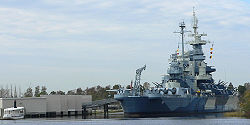
- Louise Wells Cameron Art Museum
- Airlie Gardens
- The Bellamy Mansion
- Cape Fear Museum
- Cape Fear Serpentarium
- The Children's Museum of Wilmington
- The Cotton Exchange Shopping Center
- Fort Fisher Historic Area
- New Hanover County Extension Service Arboretum
- North Carolina Aquarium at Fort Fisher
- North Carolina Azalea Festival
- Latimer House Museum
- EUE Screen Gems
- Sunset Park Historic District
- Thalian Hall Center for the Performing Arts
- University of North Carolina at Wilmington Arboretum
- USS North Carolina Memorial
- Wilmington Railroad Museum
- Fourth Friday Gallery Nights
Educational Institutions
Universities and Colleges
- The University of North Carolina at Wilmington supports a student population of more than 11,000 students on a 650-acre (2.6 km2) campus.[26]
- Cape Fear Community College operates from two campus locations, one in downtown Wilmington the other in Northern New Hanover County. Over 26,000 students take classes each year at the college with enrollment in credit programs now topping 7,200.
- Shaw University, Has a satellite campus in the downtown area right off of the waterfront. It has about 312 students and 15 faculty members.
Academies and alternate schools
- Friends School of Wilmington
- The Lyceum Academy
- Cape Fear Academy
- Wilmington Christian Academy
- St. Mark Catholic School
- Wilmington Academy of Arts and Sciences
High schools
- Eugene Ashley High School
- John T. Hoggard High School
- Isaac Bear Early College High School
- Emsley A. Laney High School
- New Hanover High School
- Lakeside High School
- Wilmington Early College High School
Middle schools
- Charles P. Murray Middle School
- DC Virgo Middle School
- Emma B. Trask Middle School
- M C S Noble Middle School
- Myrtle Grove Middle School
- Roland-Grise Middle School
- Williston Middle School
Elementary schools
- Walter L. Parsley
- Carolina Beach
- Anderson
- Wrightsboro
- Wrightsville Beach
- Holly Tree
- Bellamy
- Alderman
- Winter Park
- Blair
- Bradley Creek
- Codington
- College Park
- Eaton
- Forest Hills
- GregoryMath/Sci/Tech
- Johnson
- Lake Forest
- Murrayville
- Ogden
- Pine Valley
- Freeman
- Snipes
- Sunset Park
- Williams
Pre-K Centers
- Howe
- NHCS
- Roe
- St. Mary Catholic School[27]
Notable residents
- Eugene Ashley, Jr. — Medal of Honor recipient (Vietnam; awarded posthumously), born in Wilmington in 1930 or 1931.
- Robert Ruark — sportsman and syndicated writer during the 1940s-1950s, born in Wilmington in 1915 and graduated from New Hanover High School.
- David Brinkley — American television newscaster for NBC and later ABC, born in Wilmington in 1920.
- Michael Jordan — American basketball player, grew up in Wilmington.
- Charles Kuralt — award-winning American journalist, born in Wilmington in 1934.
- Meadowlark Lemon — American basketball player and actor, born in Wilmington in 1932.
- Sugar Ray Leonard - won the gold medal in boxing at the 1976 Olympics
- Thomas Peters — early founder of Sierra Leone, who escaped from slavery in Wilmington at the beginning of the American Revolution.
- Captain William Gordon Rutherfurd — commanded the HMS HMS Swiftsure during the Battle of Trafalgar, born in Wilmington in 1765.
- Sonny Jurgensen — Washington Redskins quarterback
- Roman Gabriel — Los Angeles Rams quarterback; 1969 NFL Most Valuable Player
- Willie Stargell — Pittsburgh Pirates outfielder and 1st baseman
- Trot Nixon — New York Mets outfielder
- Hilarie Burton - Former MTV VJ and Actress playing Peyton Sawyer on One Tree Hill
- Sophia Bush - Actress playing Brooke Davis on the CW's One Tree Hill
- James Lafferty - Actor playing Nathan Scott on One Tree Hill
- Charlie Daniels - Grew up in Wilmington
- Joshua Jackson - Actor, began living in Wilmington during his time on Dawson's Creek
- Chad Michael Murray - Actor playing Lucas Scott on The CW's One Tree Hill
- Stephanie Courtemanche - Actress playing as a telephone rep on Time Warner Cable]]
- Kaos - Webmaster of the oldest Britney Spears site on the internet www.britneyspears.org]
References
- ↑ 1.0 1.1 1.2 "American FactFinder". United States Census Bureau. Retrieved on 2008-01-31.
- ↑ "US Board on Geographic Names". United States Geological Survey (2007-10-25). Retrieved on 2008-01-31.
- ↑ "Find a County". National Association of Counties. Retrieved on 2008-01-31.
- ↑ "Table 4: Annual Estimates of the Population for Incorporated Places in North Carolina, Listed Alphabetically: April 1, 2000 to July 1, 2007" (CSV). 2007 Population Estimates. United States Census Bureau, Population Division (2008-07-10). Retrieved on 2008-09-08.
- ↑ METROPOLITAN STATISTICAL AREAS AND COMPONENTS, Office of Management and Budget, 2007-05-11. Accessed 2008-07-30.
- ↑ "Annual Estimates of the Population of Metropolitan and Micropolitan Statistical Areas: April 1, 2000 to July 1, 2007 (CBSA-EST2007-01)" (CSV). 2007 Population Estimates. United States Census Bureau, Population Division (2008-03-27). Retrieved on 2008-09-15.
- ↑ Wilmington, North Carolina | Dozen Distinctive Destinations 2008 | The National Trust for Historic Preservation
- ↑ http://www.uscg.mil/community/coast_guard_cities.htm
- ↑ USCGC Diligence (WMEC-616)
- ↑ http://www.imdb.com/List?endings=on&&locations=Wilmington,%20North%20Carolina,%20USA&&heading=18;with+locations+including;Wilmington,%20North%20Carolina,%20USA
- ↑ "US Gazetteer files: 2000 and 1990". United States Census Bureau (2005-05-03). Retrieved on 2008-01-31.
- ↑ "Weather.com: Weather Channel Historical Weather for Wilmington, North Carolina, United States of America". Retrieved on August 7, 2007.
- ↑ 1898 Wilmington Race Riot - Final Report, May 31, 2006
- ↑ 600 Kilometers
- ↑ Wilmington, N.C., to test mandatory switch to digital TV - USATODAY.com
- ↑ | StarNewsOnline.com | Star-News | Wilmington, NC
- ↑ FCC Confirms Wilmington as Digital Test Market - TVWeek - News
- ↑ Star-News: "Local TV broadcasts make switch to digital" (9/8/2008)
- ↑ Thalian Hall
- ↑ UNCW College of Arts & Sciences
- ↑ Wilmington Symphony Orchestra Home Page
- ↑ WE Fest XII - May 22-26, 2008 - Wilmington, NC
- ↑ Cape Fear Jazz Asscociation, wilmington north carolina
- ↑ Cape Fear Blues Society - Wilmington, NC
- ↑ "official Cape Fear Fugby website".
- ↑ UNC Wilmington Factsheet. http://uncw.edu/facts/documents/factsheet.pdf
- ↑ http://teacherweb.com/NC/StMaryWilmington/SchoolHomePage/SDHP1.stm
External links
- Official website of Wilmington, NC
- Official website of New Hanover County, NC
- Wilmington and Cape Fear Visitor's Bureau
- Wilmington.net Travel Resources
- Wilmington Area Information
- Wilmington Area Cultural Calendar
- Wilmington travel guide from Wikitravel
|
|||||||||||||||||
|
